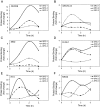Differential regulation of native estrogen receptor-regulatory elements by estradiol, tamoxifen, and raloxifene
- PMID: 17962382
- PMCID: PMC2234590
- DOI: 10.1210/me.2007-0340
Differential regulation of native estrogen receptor-regulatory elements by estradiol, tamoxifen, and raloxifene
Abstract
Estrogen receptors (ERs) regulate gene transcription by interacting with regulatory elements. Most information regarding how ER activates genes has come from studies using a small set of target genes or simple consensus sequences such as estrogen response element, activator protein 1, and Sp1 elements. However, these elements cannot explain the differences in gene regulation patterns and clinical effects observed with estradiol (E(2)) and selective estrogen receptor modulators. To obtain a greater understanding of how E(2) and selective estrogen receptor modulators differentially regulate genes, it is necessary to investigate their action on a more comprehensive set of native regulatory elements derived from ER target genes. Here we used chromatin immunoprecipitation-cloning and sequencing to isolate 173 regulatory elements associated with ERalpha. Most elements were found in the introns (38%) and regions greater than 10 kb upstream of the transcription initiation site (38%); 24% of the elements were found in the proximal promoter region (<10 kb). Only 11% of the elements contained a classical estrogen response element; 23% of the elements did not have any known response elements, including one derived from the naked cuticle homolog gene, which was associated with the recruitment of p160 coactivators. Transfection studies found that 80% of the 173 elements were regulated by E(2), raloxifene, or tamoxifen with ERalpha or ERbeta. Tamoxifen was more effective than raloxifene at activating the elements with ERalpha, whereas raloxifene was superior with ERbeta. Our findings demonstrate that E(2), tamoxifen, and raloxifene differentially regulate native ER-regulatory elements isolated by chromatin immunoprecipitation with ERalpha and ERbeta.
Figures




Similar articles
-
Multiple transcription factor elements collaborate with estrogen receptor alpha to activate an inducible estrogen response element in the NKG2E gene.Endocrinology. 2007 Jul;148(7):3449-58. doi: 10.1210/en.2006-1632. Epub 2007 Mar 29. Endocrinology. 2007. PMID: 17395694
-
Cell type- and estrogen receptor-subtype specific regulation of selective estrogen receptor modulator regulatory elements.Mol Cell Endocrinol. 2009 Feb 27;299(2):204-11. doi: 10.1016/j.mce.2008.10.050. Epub 2008 Nov 18. Mol Cell Endocrinol. 2009. PMID: 19059307 Free PMC article.
-
Regulation of estrogen target genes and growth by selective estrogen-receptor modulators in endometrial cancer cells.Gynecol Oncol. 2002 Jun;85(3):498-506. doi: 10.1006/gyno.2002.6659. Gynecol Oncol. 2002. PMID: 12051881
-
Molecular mechanisms of estrogen action: selective ligands and receptor pharmacology.J Steroid Biochem Mol Biol. 2000 Nov 30;74(5):279-85. doi: 10.1016/s0960-0760(00)00104-7. J Steroid Biochem Mol Biol. 2000. PMID: 11162936 Review.
-
Regulation of specific target genes and biological responses by estrogen receptor subtype agonists.Curr Opin Pharmacol. 2010 Dec;10(6):629-36. doi: 10.1016/j.coph.2010.09.009. Epub 2010 Oct 14. Curr Opin Pharmacol. 2010. PMID: 20951642 Free PMC article. Review.
Cited by
-
A role for Sp1 in transcriptional regulation of phosphatidylethanolamine N-methyltransferase in liver and 3T3-L1 adipocytes.J Biol Chem. 2010 Apr 16;285(16):11880-91. doi: 10.1074/jbc.M110.109843. Epub 2010 Feb 11. J Biol Chem. 2010. PMID: 20150657 Free PMC article.
-
The guanine nucleotide exchange factor, Spata13, influences social behaviour and nocturnal activity.Mamm Genome. 2019 Apr;30(3-4):54-62. doi: 10.1007/s00335-019-09800-9. Epub 2019 Apr 24. Mamm Genome. 2019. PMID: 31020388 Free PMC article.
-
Development of a novel molecular sensor for imaging estrogen receptor-coactivator protein-protein interactions.PLoS One. 2012;7(8):e44160. doi: 10.1371/journal.pone.0044160. Epub 2012 Aug 28. PLoS One. 2012. PMID: 22952913 Free PMC article.
-
Lipidic Nano-Sized Emulsomes Potentiates the Cytotoxic and Apoptotic Effects of Raloxifene Hydrochloride in MCF-7 Human Breast Cancer Cells: Factorial Analysis and In Vitro Anti-Tumor Activity Assessment.Pharmaceutics. 2021 May 24;13(6):783. doi: 10.3390/pharmaceutics13060783. Pharmaceutics. 2021. Retraction in: Pharmaceutics. 2024 Jan 30;16(2):195. doi: 10.3390/pharmaceutics16020195. PMID: 34073780 Free PMC article. Retracted.
-
Estrogen receptor-beta and breast cancer: translating biology into clinical practice.Steroids. 2012 Jun;77(7):727-37. doi: 10.1016/j.steroids.2012.03.008. Epub 2012 Mar 29. Steroids. 2012. PMID: 22465878 Free PMC article. Review.
References
-
- Writing Group for the Women’s Health Initiative 2002 Risks and benefits of estrogen plus progestin in healthy postmenopausal women: principal results From the Women’s Health Initiative randomized controlled trial. JAMA 288:321–333 - PubMed
-
- MacGregor JI, Jordan VC 1998 Basic guide to the mechanisms of antiestrogen action. Pharmacol Rev 50:151–196 - PubMed
-
- Jordan VC 2004 Selective estrogen receptor modulation: concept and consequences in cancer. Cancer Cell 5:207–213 - PubMed
-
- Cummings S, Eckert S, Krueger K, Grady D, Powles T, Cauley J, Norton L, Nickelsen T, Bjarnason N, Morrow M, Lippman ME, Black D, Glusman J, Costa A, Jordan V 1999 The effect of raloxifene on risk of breast cancer in postmenopausal women. JAMA [Erratum (1999) 282:2184] 281:2189–2197 - PubMed
-
- Ettinger B, Black D, Mitlak B, Knickerbocker R, Nickelsen T, Genant H, Christiansen C, Delmas P 1999 Reduction of vertebral fracture risk in postmenopausal women with osteoporosis treated with raloxifene. Results from a 3-year randomized clinical trial. JAMA 282:637–644 - PubMed
Publication types
MeSH terms
Substances
Grants and funding
LinkOut - more resources
Full Text Sources
Research Materials
Miscellaneous

